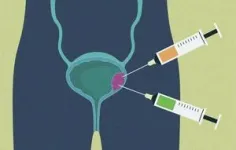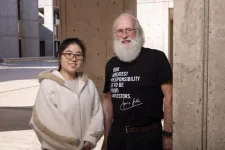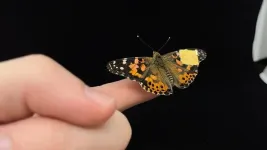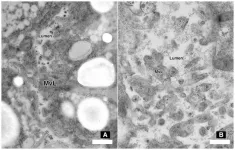(Press-News.org) The University of Virginia School of Engineering and Applied Science is set to revolutionize materials science with the development of a state-of-the-art electromagnetic levitation (EML) system, funded by a competitive Defense University Research Instrumentation Program (DURIP) grant. Designed to operate in extreme conditions, the system enables researchers to study ultra-high-temperature ceramics (UHTCs) in their solid and molten states — unlocking new possibilities for aerospace, defense and industrial applications.
Rethinking High-Temperature Research
Traditional methods of studying UHTCs are limited by the challenges of chemical contamination at extreme temperatures. The EML system’s container-less design, which combines induction and laser heating, avoids this pitfall, offering unparalleled precision. This novel system can simulate environments from a vacuum to high-pressure atmospheres while heating materials above 2,000 degrees Celsius — essential for characterizing UHTCs like carbides, borides and nitrides.
By understanding properties such as melting points, thermal expansion and surface tension, the system will accelerate the design of materials capable of withstanding the unforgiving conditions of hypersonic flight and high-temperature manufacturing.
A Game-Changer for U.S. Research
Currently, no advanced electromagnetic levitation systems are operational in the U.S., giving this project a unique edge. Other EML facilities in Germany and Japan validated the feasibility of such systems, but these facilities lacked the capability to achieve complete melting of UHTCs afforded by supplemental laser heating. UVA’s EML system bridges this gap, empowering researchers to gather high-precision data that was previously out of reach.
“The EML system represents a paradigm shift in our ability to study and engineer materials for extreme environments,” said Elizabeth Opila, the project’s principal investigator, the Rolls Royce Commonwealth Professor of Engineering and chair of the Department of Materials Science and Engineering. “This technology will not only advance the field but also train the next generation of materials scientists for critical applications.”
Broader Impacts
The system’s modular design ensures flexibility for future innovations, including integration with the Advanced Photon Source at Argonne National Laboratory. This capability enables advanced studies such as in situ X-ray diffraction and high-temperature oxidation measurements, essential for aerospace and energy industries.
Beyond its scientific contributions, the EML system will provide hands-on training for graduate students and researchers, equipping them with the skills to drive future innovations. “This is more than just a novel piece of equipment,” Opila added. “It’s a platform for discovery and education that will shape the future of materials science.”
Opila, an expert in high-temperature materials, is a former research scientist at NASA Glen Research Center and has led numerous Department of Defense-funded projects advancing refractory materials.
About the Grant
The EML system is funded through a Defense University Research Instrumentation Program grant, awarded by the Army Research Office. The $318,190 grant will cover the base instrument, including two radio frequency power supplies, a high-vacuum to atmospheric pressure chamber, non-contact temperature measurement tools and high-speed imaging equipment. This phase will also include initial levitation and heating tests, paving the way for advanced diagnostics and modular upgrades to high pressure conditions in subsequent phases.
END
UVA receives DURIP grant for cutting-edge ceramic research system
2025-01-14
ELSE PRESS RELEASES FROM THIS DATE:
Gene editing extends lifespan in mouse model of prion disease
2025-01-14
Researchers at the Broad Institute of MIT and Harvard have developed a gene-editing treatment for prion disease that extends lifespan by about 50 percent in a mouse model of the fatal neurodegenerative condition. The treatment, which uses base editing to make a single-letter change in DNA, reduced levels of the disease-causing prion protein in the brain by as much as 60 percent.
There is currently no cure for prion disease, and the new approach could be an important step towards treatments that prevent the disease or ...
Putting a lid on excess cholesterol to halt bladder cancer cell growth
2025-01-14
LA JOLLA (January 14, 2025)—Like all cancers, bladder cancer develops when abnormal cells start to multiply out of control. But what if we could put a lid on their growth?
Previous studies showed that a protein called PIN1 helps cancers initiate and progress, but its exact role in tumor development has remained unclear. Now, cancer biologists at the Salk Institute have discovered that PIN1 is a significant driver of bladder cancer and revealed that it works by triggering the synthesis of cholesterol—a membrane lipid essential for cancer cells to grow.
After mapping out the molecular pathway between PIN1 and ...
Genetic mutation linked to higher SARS-CoV-2 risk
2025-01-14
RIVERSIDE, Calif. -- Researchers have identified a novel genetic risk factor for SARS-CoV-2 infection, providing new insights into the virus’ ability to invade human cells. SARS-CoV-2 is the virus that spreads COVID-19.
The study, led by immunologist Declan McCole at the University of California, Riverside, shows that a loss-of-function variant in the phosphatase gene PTPN2, commonly associated with autoimmune diseases, can increase expression of the SARS-CoV-2 receptor ACE2, making cells more susceptible to viral invasion.
A loss-of-function ...
UC Irvine, Columbia University researchers invent soft, bioelectronic sensor implant
2025-01-14
Irvine, Calif., Jan. 14, 2025 — Researchers at the University of California, Irvine and New York’s Columbia University have embedded transistors in a soft, conformable material to create a biocompatible sensor implant that monitors neurological functions through successive phases of a patient’s development.
In a paper published recently in Nature Communications, the UC Irvine scientists describe their construction of complementary, internal, ion-gated, organic electrochemical transistors that are more amenable ...
Harnessing nature to defend soybean roots
2025-01-14
The microscopic soybean cyst nematode (SCN) may be small, but it has a massive impact. This pest latches onto soybean roots, feeding on their nutrients and leaving a trail of destruction that costs farmers billions in yield losses each year. Unfortunately, current methods to combat SCN are faltering as the pest grows resistant to traditional controls. But new research is now offering a glimmer of hope.
A collaborative team of scientists from BASF Agricultural Solutions and the Advanced Bioimaging Laboratory at the Donald Danforth Plant Science Center are working on a potential solution: ...
Yes, college students gain holiday weight too—but in the form of muscle not fat
2025-01-14
With the holidays behind us, many Americans are seeing the numbers on the scale go up a pound or two. In fact, data shows that many American midlife and older adults gain 1 to 1.5 pounds over the November through January holiday period. Though not harmful on its own, even a small amount of holiday weight gain in the form of fat can negatively affect health. People often fail to lose the extra weight, which leads to significant cumulative weight gain over the years and contributes to health concerns.
Based on new research, we now know that college students gain the same amount of weight as older ...
Beach guardians: How hidden microbes protect coastal waters in a changing climate
2025-01-14
A hidden world teeming with life lies below beach sands. New Stanford-led research sheds light on how microbial communities in coastal groundwater respond to infiltrating seawater. The study, published Dec. 22 in Environmental Microbiology, reveals the diversity of microbial life inhabiting these critical ecosystems and what might happen if they are inundated by rising seas.
“Beaches can act as a filter between land and sea, processing groundwater and associated chemicals before they reach the ocean,” said study co-first author Jessica Bullington, a Ph.D. student in Earth system science in the Stanford Doerr School of Sustainability. “Understanding ...
Rice researchers unlock new insights into tellurene, paving the way for next-gen electronics
2025-01-14
HOUSTON – (Jan. 14, 2025) – To describe how matter works at infinitesimal scales, researchers designate collective behaviors with single concepts ⎯ like calling a group of birds flying in sync a “flock” or “murmuration.” Known as quasiparticles, the phenomena these concepts refer to could be the key to next-generation technologies.
In a recent study published in Science Advances, a team of researchers led by Shengxi Huang, associate professor of electrical and computer engineering and materials science and nanoengineering at Rice, describe how one such type of quasiparticle ⎯ polarons ⎯ behaves in tellurene, a nanomaterial first synthesized ...
New potential treatment for inherited blinding disease retinitis pigmentosa
2025-01-14
Two new compounds may be able to treat retinitis pigmentosa, a group of inherited eye diseases that cause blindness. The compounds, described in a study published January 14th in the open-access journal PLOS Biology by Beata Jastrzebska from Case Western Reserve University, US, and colleagues, were identified using a virtual screening approach.
In retinitis pigmentosa, the retina protein rhodopsin is often misfolded due to genetic mutations, causing retinal cells to die off and leading to progressive blindness. Small molecules to correct rhodopsin folding are urgently needed to treat the estimated 100,000 ...
Following a 2005 policy, episiotomy rates have reduced in France without an overall increase in anal sphincter injuries during labor, with more research needed to confirm the safest rate of episiotomi
2025-01-14
Following a 2005 policy, episiotomy rates have reduced in France without an overall increase in anal sphincter injuries during labor, with more research needed to confirm the safest rate of episiotomies and the risks to specific subgroups
In your coverage, please use this URL to provide access to the freely available paper in PLOS Medicine: http://journals.plos.org/plosmedicine/article?id=10.1371/journal.pmed.1004501
Article title: Episiotomies and obstetric anal sphincter injuries following a restrictive episiotomy policy in France: An analysis of the 2010, 2016, and 2021 National Perinatal Surveys
Author countries: France, Switzerland
Funding: ...







